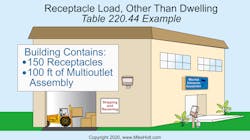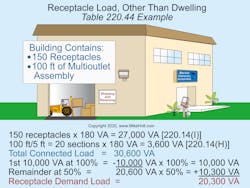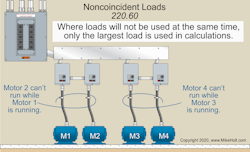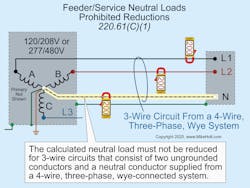Based on the 2020 National Electrical Code.
Part 1 of this two-part series taught you how to calculate branch-circuit loads. Now let's review how to perform feeder and service load calculations.
Before performing feeder and service load calculations, characterize the loads and determine where demand factors apply. For example, not all luminaires are expected to be on at the same time. Therefore, you can apply demand factors to the general lighting load per Table 220.42. These demand factors do not apply to the calculated load of feeders or services supplying areas where the entire lighting is likely to be used at once, such as ballrooms or dining rooms.
For dwelling units, the demand factors of Table 220.42 apply to the two small-appliance circuits of 1,500VA [Sec. 220.52(A)] and a laundry circuit of 1,500VA [Sec. 220.52(B)]. Include these as part of the general lighting load calculation, along with the required lighting and general-use receptacle load of 3VA per sq ft [Sec. 220.14(J)].
Remember to subtract 3,000VA from 120,000VA when using Table 220.42, since the 35% applies only to the 3,001VA to 120,000VA range.
Non-dwelling unit receptacles
To determine the load for general-purpose receptacle outlets [Sec. 220.14(I)] and fixed multioutlet assemblies [Sec. 220.14(H)]:
• Add the receptacle and fixed multioutlet assembly VA load to the general lighting load [Table 220.12] and adjust this value by the demand factors in Table 220.42, or
• Apply a 50% demand factor to that portion of the receptacle and fixed multioutlet receptacle loads that exceed 10kVA [Sec. 220.44].
Let’s run through an example problem to clarify the calculation steps.
Question: What is the demand load for 150 general-purpose receptacles and 100 ft of fixed multioutlet assembly in a commercial occupancy? The appliances powered by the multioutlet assembly are not used simultaneously (Fig. 1).
Solution: Step 1: Determine the total connected load.
Receptacle load = 150 receptacles × 180VA = 27,000VA [Sec. 220.14(I)]
Multioutlet load = 100 ft ÷ 5 ft = 20
Multioutlet load = 20 sections × 180VA = 3,600VA [Sec. 220.14(H)]
Step 2: Apply the Table 220.44 demand factors.
Total connected load = 30,600VA
First 10,000VA at 100% = 10,000VA × 100% = 10,000VA
Remainder at 50% = 20,600VA × 50% = 10,300VA
Answer: Total receptacle calculated load = 20,300VA
Motors and appliances in dwelling units
Calculate the feeder conductor for motor loads per Sec. 430.24. Conductors supplying motors and other load(s) must have an ampacity of at least the sum of each of the following:
(1) 125% of the full-load current rating of the highest rated motor.
(2) Sum of the full-load current ratings of all the other motors in the group.
(3) 100% of the non-continuous nonmotor load(s).
(4) 125% of the continuous nonmotor load(s).
Small-appliance and laundry circuits in dwelling units
Calculate the loads for each of these 20A circuits as follows:
• Small-appliance circuit covered by Sec. 210.11(C)(1) is 1,500VA; you can apply the general lighting demand factors in Table 220.42 [Sec. 220.52(A)].
• Laundry circuit covered by Sec. 210.11(C)(2) is 1,500VA; you can apply the general lighting demand factors in Table 220.42 [Sec. 220.52(B)].
Appliance loads in dwelling units
You can apply a demand factor of 75% to the total connected load of four or more appliances rated ¼ hp or greater, or 500W or greater, that are fastened in place [Sec. 220.53].
Do not apply this demand factor to:
(1) Household electric cooking equipment fastened in place [Sec. 220.55].
(2) Clothes dryers [Sec. 220.54].
(3) Space-heating equipment [Sec. 220.51].
(4) Air-conditioning (A/C) equipment [Sec. 220.50].
The service/feeder load for electric clothes dryers must be at least 5,000W (5,000VA) or the nameplate rating of the equipment if more than 5,000W (5,000VA). For load calculations in this section, kVA is the same a kW and VA is the same as W [Sec. 220.54].
Household electric clothes dryers in dwelling units
When a building contains five or more clothes dryers, you can apply the demand factors in Table 220.54 to the total connected dryer load.
Household electric appliances in dwelling units
For household cooking appliances rated over 1.75kW, you can calculate the feeder/service demand load per the demand factors of Table 220.55.
The four notes to Table 220.55 may affect your calculations. For example, Note 1 describes one set of criteria for which you must raise the maximum demand in Column C by 5% for each additional kilowatt rating and Note 2 describes another. Note 4 provides both a “permissible” and a “must.”
Commercial kitchen equipment
You can use Table 220.56 to calculate the demand load for thermostat-controlled or intermittently used commercial kitchen equipment [Sec. 220.56]. The kitchen equipment feeder/service calculated load must be at least the sum of the two largest kitchen equipment loads.
Table 220.56 demand factors do not apply to space-heating, ventilating, or A/C equipment.
Non-coincident loads
If it is unlikely that two or more loads will be used simultaneously, use only the largest load for load calculations [Sec. 220.60]. Where a motor is part of the non-coincident load and is not the largest non-coincident load, use 125% of the motor load if it is the largest motor (Fig. 2).
Neutral load
The neutral load for feeders or services is based on the maximum calculated load between the neutral conductor and any one-phase conductor [Sec. 220.61(A)]. Line-to-line loads are not considered in the calculation.
Permitted reductions include:
• Cooking loads and dryers. The feeder/service neutral load for household electric ranges, wall-mounted ovens, or counter-mounted cooking units can be calculated at 70% of the cooking equipment demand load as determined per Table 220.55 [Sec. 220.61(B)(1)]. You can apply the same reduction to dryers, per Table 220.54 [Sec. 220.61(B)(1)].
• Over 200A neutral. The feeder/service calculated neutral load for a 3-wire, single-phase or 4-wire, 3-phase system can be calculated at 70% for that portion of the unbalanced load over 200A [Sec. 220.61(B)(2)]. See Annex D, Example D4(a) Multifamily Dwelling.
Prohibited reductions include:
• 3-wire circuits from 4-wire, wye-connected systems [Sec. 220.61(C)(1), as shown in Fig. 3.
• Nonlinear loads [Sec. 220.61(C)(2)].
Optional load calculation, dwellings
If the load for a dwelling unit is at least 100A, you can calculate the service load by adding the calculated general load [Sec. 220.82(B)] to the calculated HVAC load [Sec. 220.82(C)].
Some rules for calculating the general load include:
• Determine the neutral load per 220.61.
• The demand load must be at least 100% of the first 10kVA, plus 40% of the remainder kVA for the following loads:
Base the general load on 3VA per sq ft for general lighting and general-use receptacles.
Add 1,500VA for each 20A small-appliance circuit as required by Sec. 210.11(C)(1)(a) with at least two circuits per dwelling unit, and 1,500VA for each 20A laundry circuit as required by Sec. 210.11(C)(2).
Let’s run through an example problem now to clarify this procedure.
Question: Using the optional calculation method, what size service is required for a 1,500-sq-ft dwelling unit containing the following loads?
Dishwasher (1,200VA)
Garbage disposal (900VA)
Cooktop (6,000VA)
Oven (3,000VA)
Clothes dryer (4,000VA)
Water heater (4,500VA)
Heat-pump compressor rated 28A at 240V, with supplemental electric heat having a rating of 7kW.
Solution: Step 1: Determine the total feeder/service calculated load.
(1) Lighting, receptacles, and appliance calculated load:
Small appliance: 1,500VA × 2 = 3,000VA
Laundry: 1,500VA × 1 = 1,500VA
General lighting: 1,500 sq ft × 3VA/sq ft = 4,500VA
Dishwasher: 1,200VA × 1 = 1,200VA
Garbage disposal: 900VA × 1 = 900VA
Cooktop: 6,000VA × 1 = 6,000VA
Oven: 3,000VA × 1 = 3,000VA
Dryer: 4,000VA × 1 = 4,000VA
Water heater: 4,500VA × 1 = 4,500VA
Total calculated load = 28,600VA
First 10,000VA at 100%. Remainder at 40% = 18,600VA × 40% = 7,440VA
Demand load = 17,440VA [Sec. 220.82(B)]
(2) Largest of A/C or heat [Sec. 220.82(C)]
Heat pump compressor at 100%: 240V × 28A = 6,720VA
Supplemental heat at 65% = 7,000VA × 65% = 4,550VA
Demand load = 11,270VA [Sec. 220.82(C)]
Total demand load [Sec. 220.82(B) and (C)] = 17,440VA + 11,270VA = 28,710VA
Step 2: Determine the service size in amperes.
I = volt-ampere ÷ volts = 28,710VA ÷ 240V = 120A
The minimum size service would be 125A. [Sec. 240.6(A)]
You would do something similar for a multifamily building, per Sec. 220.84, but what if you have only two units supplied by a single feeder? Where the standard calculated load per Art. 220 Part III exceeds that for three identical units calculated per Sec. 220.84, you can use the lesser of the two calculated loads.
Take a load off
Improper application of demand factors can result in a costly overbuild on the one hand or a dangerous underbuild on the other. One helpful tip for avoiding this error is to annotate your calculations with the Table reference at each place where you use a Table. Then, when you review your calculations, double-check that you used the correct Table and the correct value from it.
These materials are provided to us by Mike Holt Enterprises in Leesburg, Fla. To view Code training materials offered by this company, visit www.mikeholt.com/code.
About the Author

Mike Holt
Mike Holt is the owner of Mike Holt Enterprises (www.MikeHolt.com), one of the largest electrical publishers in the United States. He earned a master's degree in the Business Administration Program (MBA) from the University of Miami. He earned his reputation as a National Electrical Code (NEC) expert by working his way up through the electrical trade. Formally a construction editor for two different trade publications, Mike started his career as an apprentice electrician and eventually became a master electrician, an electrical inspector, a contractor, and an educator. Mike has taught more than 1,000 classes on 30 different electrical-related subjects — ranging from alarm installations to exam preparation and voltage drop calculations. He continues to produce seminars, videos, books, and online training for the trade as well as contribute monthly Code content to EC&M magazine.




